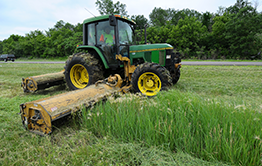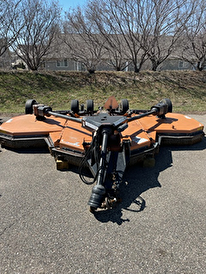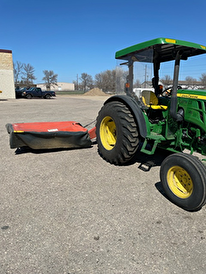
BY ALAN FORSBERG, P.E., RETIRED BLUE EARTH COUNTY ENGINEER
During a recent vacation, I had the opportunity to strike up a conversation with a farmer from north of Toronto, Canada. He was concerned his local road agency was not maintaining the road ditches. Tall grass, brush, and even volunteer trees adjacent to the road were creating problems for him—the tall vegetation blocked sight distance for cross traffic at intersections and for animals crossing the road, created snow drifts on the road, and in some cases hit the side of his equipment.
To gain a better understanding of the need for mowing ditches, I talked to several county engineers and maintenance supervisors in Minnesota. I found there are pros and cons for mowing and spraying to control vegetation. Mowing provides improved sight distance for traffic, reduces snow drifting onto the road, lessens the need for chemicals to control noxious weeds, and, when baled, provides feed for farm animals. Some landowners also prefer the mowed-lawn appearance adjacent to their properties. However, left natural, ditches can provide habitat for wildlife and are consistent with efforts to provide food for pollinators and land for native grasses.
The MnDOT standard specification ditch grass seed mixes work well. They establish quickly, protect from erosion, and require little maintenance. Native grass seed mixes are expensive and can be slow to establish, but they do have a place in select locations. With their deep root systems, native grasses are drought tolerant, promote water infiltration, and provide good habitat for wildlife. (Please see the turfgass article for more.)
Laws and rules affecting ditch mowing
Minnesota Statute 160.232, Mowing Ditches Outside Cities, specifies ditches may only be mowed during the month of August. However, there are several important exceptions summarized below. You are urged to review the law for more detail and contact your local government attorney for interpretation.
- “The first 8 feet away from the road surface, or shoulder if one exists, may be mowed at any time.”
- “A right-of-way may be mowed as necessary to maintain sight distance for safety. Mowing may also be done at other times by ordinance of a local road authority providing it is consistent with the Commissioner’s rules.”
- Right-of-way may be mowed, burned, or tilled to prepare for establishment of vegetative cover at all times.
MS 160.2715, Right-of-Way Use; Misdemeanors, addresses rules for use of the right-of-way such as fencing, driveways, and ditch obstructions. Although not dealing with mowing, the law discusses issues of importance to local road authorities.
MS 18D, The Minnesota Noxious Weed List, requires listed weeds be eradicated or controlled. It includes 32 prohibited weeds added to the list between 1872 and 2023; 19 restricted noxious weeds added between 2013 and 2023; and 6 specialty regulated plants added between 2010 and 2023. There are also weeds on county and federal lists. It is not feasible for a local agency to inventory its right-of-way for all these weeds and eradicate and control them. Consequently, local agencies may be forced to prioritize noxious weed control based on agricultural needs and citizen complaints.
Counties receive requests to not mow from adjacent landowners who prefer to mow ditches for a lawn appearance or baling for animal feed. Also, some crops such as grapes are extremely sensitive to chemical sprays. As a result, some counties maintain “Do Not Mow” maps for their mow and spray operators.
Some right-of-way is owned in fee title by the road agency, others by easement. Where a transportation easement exists, the land is owned by the underlying owner, with the transportation agency having the right to use the land for transportation purposes. It is not clear if the agency has the right to restrict mowing or spraying on easement lands; agencies should contact their attorney for clarification.
Threatened and endangered species
The United States Fish and Wildlife Service (USFWS) maintains the list of endangered and threatened species, two of which may affect ditch vegetation maintenance.
The rusty patched bumble bee was listed as an endangered species by final rule in January of 2017. Guidance has been provided on vegetation maintenance, but no specific prohibitions on mowing or spraying are currently in force.
The monarch butterfly has been found by the USFWS to warrant designation as an endangered species; however, as of April 2023, it is not listed but its status is to be annually reviewed. A local agency may enter into a Candidate Conservation Agreement with Assurances (CCAA) with the USFWS. Under this agreement, the local agency agrees to set aside 5 percent of the right-of-way to be managed for monarch butterfly habitat, and the rest of the right-of-way would not be restricted. The CCAA also provides an incentive to enter the agreement by assuring the local government that restrictions would not become more severe with time. The monarch butterfly may potentially be listed soon, so if a local government is interested, it should sign up soon—the agreement may not be available after the monarch butterfly is listed. It is not clear if the local government has the authority to enter into the agreement for easement lands where rights are for transportation purposes only; agencies should contact their attorney for clarification.
The USFWS website includes tools for determining potential habitat areas and vegetation management guidelines for both the rusty patched bumble bee and the monarch butterfly. You may also contact the MnDOT district maintenance engineer for their identified areas as a guide.
For plants on the endangered list, contact the Minnesota Department of Natural Resources for plants that may be in your area. The federal list applies only to federal lands and federal permits. However, the MnDNR has included these plus more species on its list of endangered plants. Your MnDNR-area ecologist can identify areas of potential habitat for the endangered plants.
Mowing policies
Local agencies must consider state laws on mowing season, noxious weeds, threatened/endangered species rules, and adjacent landowner preferences.
Policies shared by agencies I spoke with include mowing shoulder cuts and intersection sight distances as needed for safe sight distance. Once a year, or in some cases every second or third year, agencies mow the entire right-of-way to prevent the establishment of brush and volunteer trees. Spot spraying or mowing may be used to eradicate or control noxious weeds. Some agencies develop and maintain a “no mow” map or list for operators; some issue a permit or letter of agreement making the landowner responsible for mowing or spraying on “no mow” ditches.
Safety considerations
With fewer and larger farms, fewer young people with experience operating farm equipment are available for summer part-time mowing jobs. Adequate training for operating tractors and mowers on slopes is therefore more essential than ever.

Some safety considerations applying specifically to ditch mowing include:
- Always wear a seatbelt and use a tractor with a rollover protection structure. You need to use both! Operators must always wear eye and ear protection and wear a safety vest.
- If operating on a slope, keep the mower bar on the uphill side.
- Operate in pairs if feasible for assistance with equipment maintenance and in the event of a rollover.
- Be alert for ends of culverts and animal holes, which may cause the tractor to roll over on a steep slope.
- If the tractor does not have a cab, a plexiglass shield behind and on the side of the operator will provide protection from objects thrown by the mower. For rotary mowers, ensure the tarp or chains preventing thrown objects is in place.

Evolution of ditch mowing equipment
The need to mow road ditches has existed since rural public roads were established. The equipment has evolved substantially.
- Horse-drawn, sickle-bar mowers were small, slow, and labor intensive. However, they were a substantial improvement to cutting by hand. From today’s perspective, they were carbon free and fertilized the ditches. There was no air conditioning, but operators had excellent ventilation. The top photo shows a horse-drawn mower made at the Minnesota Prison. Add a team and away you go!
- Small tractor side-mounted mower, basically adapting the horse-drawn implement to a small tractor. The middle photo shows a Vicon brand mower on a John Deere tractor as an example.
- Responding to the current need with labor shortages and laws restricting the mowing season, local governments are using large tractors with rotary mowers mounted on the rear, side, or both, or folding “batwing”-style towed mowers. A recent innovation is a tow bar that allows the tractor to operate on the shoulder with the mowers down on the ditch in-slope and bottom. The large equipment is fast and efficient; however, it does not mow around objects as well as the smaller equipment and requires a graded ditch with uniform, gentle slopes. See photo of a batwing mower.

- Specialty mowers are also available that can reach difficult places for a conventional mower, such as behind guardrails and steep slopes.
Conclusion
Vegetation management has become complex, with often competing objectives. I hope this article will be of assistance in developing best management practices for your rural ditches.